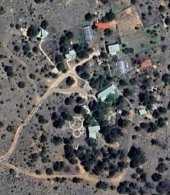
 3
3





 7
7







 5
5




The holy trinity of wholesomeness: Fred Rogers - be kind to others; Steve Irwin - be kind to animals; Bob Ross - be kind to yourself
 4
4




 3
3




paul wheaton wrote:
People were tempted to put the junkpoles in where the fat end alternates every other pole, but I think it is important to always keep the fat end down. This makes a strong barrier along the bottom to keep the chickens contained, and a "good enough" barrier at the top to keep flying chickens in and jumping deer out. Plus, it allows more light to pass down to the growies.
“There are no words to express the abyss between isolation and having one ally. It may be conceded to the mathematician that four is twice two. But two is not twice one; two is two thousand times one.”
― G. K. Chesterton

 2
2








paul wheaton wrote:
This is at basecamp where we have to use rockjacks because we cannot get a regular fencepost in the ground:
Destruction precedes creation
 1
1








paul wheaton wrote:
M Wilcox wrote:What is a rock jack?
https://permies.com/t/39351/permaculture-projects/rock-jack

Destruction precedes creation
 7
7




SKIP books, get 'em while they're hot!!! Skills to Inherit Property
See me in a movie building a massive wood staircase:Low Tech Lab Movie
 3
3




Mike Haasl wrote:After way too long, I just had a realization. Couldn't you make junk pole fences using sawmill slab wood for the vertical pieces? Use junk poles for the horizontals but stand slabs up for the body of the fence...
In my area you can get a big pickup load of sawmill slabs for $50 or less. I'm guessing you could surround an acre with two loads that size. Thoughts?
Visit Redhawk's soil series: https://permies.com/wiki/redhawk-soil
How permies.com works: https://permies.com/wiki/34193/permies-works-links-threads
 1
1




SKIP books, get 'em while they're hot!!! Skills to Inherit Property
See me in a movie building a massive wood staircase:Low Tech Lab Movie
 2
2




Mike Haasl wrote:After way too long, I just had a realization. Couldn't you make junk pole fences using sawmill slab wood for the vertical pieces? Use junk poles for the horizontals but stand slabs up for the body of the fence...
In my area you can get a big pickup load of sawmill slabs for $50 or less. I'm guessing you could surround an acre with two loads that size.
Thoughts?
A build too cool to miss:Mike's GreenhouseA great example:Joseph's Garden
All the soil info you'll ever need:
Redhawk's excellent soil-building series





 10
10




My tree nursery: https://mountaintimefarm.com/
 5
5




Like my shiny badges? Want your own? Check out Skills to Inherit Property!
 5
5




Alder Burns wrote:In climates amenable to it, bamboo comes to mind as another excellent material for such a fence. It grows in large invasive patches in much of the South and other warm moist climates and is often to be had for the asking.....

 This is her video over bamboo fencing.
This is her video over bamboo fencing.
#WidowBalls is doing the things he did before he died despite it being emotionally and/or physically hard to do.
Ovaries of Steel. http://HoneysLife.com
 4
4








Malek Beitinjan wrote:
paul wheaton wrote:
People were tempted to put the junkpoles in where the fat end alternates every other pole, but I think it is important to always keep the fat end down. This makes a strong barrier along the bottom to keep the chickens contained, and a "good enough" barrier at the top to keep flying chickens in and jumping deer out. Plus, it allows more light to pass down to the growies.
I'm a bit curious about this. When I was building a section of junkpole fence at WL during the SKIP event, we were told to alternate the poles so that the large end is facing down every other pole. I think it required a few more junkpoles than putting just the large ends down, but it did make a tighter fence. Does anyone have opinions on the pros/cons for this? Considering Paul wrote this 6 years ago and they've built many junkpole fences since then, the meta may have changed.




Honey Rowland wrote:
Alder Burns wrote:In climates amenable to it, bamboo comes to mind as another excellent material for such a fence. It grows in large invasive patches in much of the South and other warm moist climates and is often to be had for the asking.....
This is what I'm wanting to do and started collecting bamboo I can obtain but keep finding alternative uses for it...and folks love trading bamboo trellis for seed.
We discovered it while watching Liziqi. Her videos are peaceful and inspiring and kids and I have watched them all a few times now over the years.This is her video over bamboo fencing.
 1
1




 1
1




a peeled branch or piece of wood laid between beams of a ceiling or above the vigas for decoration.
Invasive plants are Earth's way of insisting we notice her medicines. Stephen Herrod Buhner
Everyone learns what works by learning what doesn't work. Stephen Herrod Buhner
 1
1




Anne Miller wrote:I am not sure what latillas actually means though when I asked Mr. Google, he gave me this meaning:
a peeled branch or piece of wood laid between beams of a ceiling or above the vigas for decoration.
https://www.dictionary.com/browse/latilla
That is what we use in Texas to use yucca flower stalks and branches from the Ocotillo plant.
Ocotillos are one of the easiest plants to identify because they look barren until it rains then the ocotillos bloom. So pretty with those red blooms.
 3
3








Kyrt Ryder wrote:
Deb Rebel wrote:
Kyrt Ryder wrote:
Deb Rebel wrote:At home we did a lot of square bales, natural twine, and ALWAYS when you cut a twine you had to pocket it or burlap bag it and take it with you. If nothing else a cow would always seem to get wrapped up in one or trip over it.
Thank you so much for this. I've developed a bad habit of leaving baling twine where I opened the bale until it piles up and then collected it in one go. Thus far it's been fine with my sheep and pigs, but I am looking to get into cattle when I get on larger land and- during the establishment phase when I'm likely to be supplementing with hay periodically- this could have been a disaster.
So much better learning my lesson BEFORE screwing something up.
The other issue was gophers. Not prairie dogs, those are bigger and protected in some areas. We had a continual war with gophers and filling in their burrow holes. A cow could run through and drop a foot in there and break a leg (which equaled 'burger' and an emergency butchering). Our way of thinning them was sit in the back of a pickup in the pasture and shoot them with a .22 rifle. Bait caused issues so we did it the direct route. It was important in early spring to spend a few afternoons out there thinning them out to keep the population down. Then go out with the tractor and fill things in. If anyone knows how to deal with prairie dogs, without killing, let me know. Where I live now we have those.
I've seen pigs dig up moles for chow, I imagine the same goes for Prairie Dogs and Gophers. That's part of the reason I intend to rotate pigs in pasture behind Cattle [with scratching poultry- either Turkeys or Chickens- coming in behind to clean up the mess the pigs left behind.]
It's doubtful pigs would eliminate the population without being left in there far too long for the pasture's health, but in many cases population control is all you need [and desire? considering the soil building work done by burrowing mammals.]
 2
2




 8
8




 1
1




 2
2




Geneva Upchurch wrote:I sure would love to see an update on how this junk pole fence looks now. I am considering doing something similar but worry about longevity.
Perfect The Dwelling Land




 4
4




 7
7




SKIP books, get 'em while they're hot!!! Skills to Inherit Property
See me in a movie building a massive wood staircase:Low Tech Lab Movie
 2
2




 7
7





|
This secret army of atomic robot zombie men answers only to this tiny ad:
permaculture bootcamp - learn permaculture through a little hard work
https://permies.com/wiki/bootcamp
|






